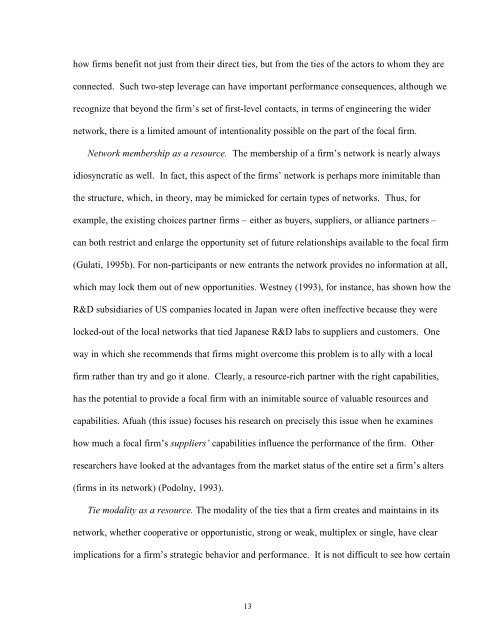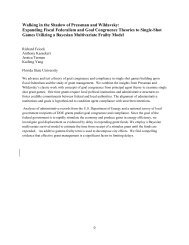STRATEGIC NETWORKS Ranjay Gulati, Nitin Nohria, Akbar Zaheer ...
STRATEGIC NETWORKS Ranjay Gulati, Nitin Nohria, Akbar Zaheer ...
STRATEGIC NETWORKS Ranjay Gulati, Nitin Nohria, Akbar Zaheer ...
You also want an ePaper? Increase the reach of your titles
YUMPU automatically turns print PDFs into web optimized ePapers that Google loves.
how firms benefit not just from their direct ties, but from the ties of the actors to whom they areconnected. Such two-step leverage can have important performance consequences, although werecognize that beyond the firm’s set of first-level contacts, in terms of engineering the widernetwork, there is a limited amount of intentionality possible on the part of the focal firm.Network membership as a resource. The membership of a firm’s network is nearly alwaysidiosyncratic as well. In fact, this aspect of the firms’ network is perhaps more inimitable thanthe structure, which, in theory, may be mimicked for certain types of networks. Thus, forexample, the existing choices partner firms – either as buyers, suppliers, or alliance partners –can both restrict and enlarge the opportunity set of future relationships available to the focal firm(<strong>Gulati</strong>, 1995b). For non-participants or new entrants the network provides no information at all,which may lock them out of new opportunities. Westney (1993), for instance, has shown how theR&D subsidiaries of US companies located in Japan were often ineffective because they werelocked-out of the local networks that tied Japanese R&D labs to suppliers and customers. Oneway in which she recommends that firms might overcome this problem is to ally with a localfirm rather than try and go it alone. Clearly, a resource-rich partner with the right capabilities,has the potential to provide a focal firm with an inimitable source of valuable resources andcapabilities. Afuah (this issue) focuses his research on precisely this issue when he examineshow much a focal firm’s suppliers’capabilities influence the performance of the firm. Otherresearchers have looked at the advantages from the market status of the entire set a firm’s alters(firms in its network) (Podolny, 1993).Tie modality as a resource. The modality of the ties that a firm creates and maintains in itsnetwork, whether cooperative or opportunistic, strong or weak, multiplex or single, have clearimplications for a firm’s strategic behavior and performance. It is not difficult to see how certain13




